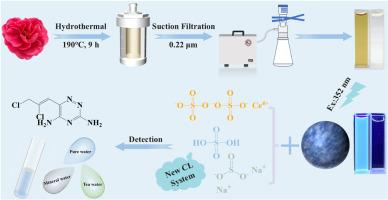基于山茶提取物的可持续合成氮自掺杂碳点用于水样中拉莫三嗪的灵敏检测
IF 4.2
3区 工程技术
Q2 CHEMISTRY, APPLIED
引用次数: 0
摘要
在生物分析和环境监测领域,利用废弃生物质开发可持续碳点纳米材料作为探针,对推进可持续化学传感技术具有重要的科学价值。该方法不仅使废弃生物质有效转化为功能纳米材料,而且为生物质资源利用提供了可持续的范例。采用一步水热法制备了以山茶花为碳氮源的氮自掺杂碳点(NCDs)。此外,我们构建了一种新型的化学发光体系(Na2SO3-CeS2O8-NCDs-H2SO4),并将其应用于水中抗癫痫药物拉莫三嗪(LTG)的高灵敏度检测。LTG的化学发光信号在体系内表现出浓度依赖的抑制效应,线性动态范围为8 × 10−5 M ~ 1 × 10−3 M,检出限为2.37 μM。目标分析物在实际水样中的加标回收率为98.63% ~ 104.49%,验证了该方法在复杂环境基质中检测LTG的适用性和可靠性。该研究为生物质废弃物资源化利用和水样中痕量药物残留绿色分析提供了创新途径。本文章由计算机程序翻译,如有差异,请以英文原文为准。

Application of sustainably Synthesized nitrogen self-doped carbon dots based on camellia extract for sensitive detection of lamotrigine in water samples
In bioanalysis and environmental monitoring, developing sustainable carbon dot nanomaterials from waste biomass as probes holds significant scientific value for advancing sustainable chemical sensing technology. The method not only enables the efficient transformation of waste biomass into functional nanomaterials but also presents a sustainable paradigm for biomass resource utilization. A one-step hydrothermal synthesis protocol was utilized for the fabrication of nitrogen self-doped carbon dots (NCDs), wherein camellia flowers functioned as dual sources of carbon and nitrogen. Furthermore, we constructed a novel chemiluminescence system (Na2SO3–CeS2O8-NCDs-H2SO4) and applied it to the highly sensitive detection of the antiepileptic drug lamotrigine (LTG) in water. The chemiluminescence signal of LTG exhibited a concentration-dependent inhibitory effect within the system, featuring a linear dynamic range of 8 × 10−5 M to 1 × 10−3 M and a detection limit of 2.37 μM. The recovery rates of the target analyte in spiked real water samples ranged from 98.63% to 104.49%, validating the applicability and reliability of this method for detecting LTG in complex environmental matrices. The research offered an innovative approach to the resource utilization of waste biomass and the green analysis of trace drug residues in water samples.
求助全文
通过发布文献求助,成功后即可免费获取论文全文。
去求助
来源期刊

Dyes and Pigments
工程技术-材料科学:纺织
CiteScore
8.20
自引率
13.30%
发文量
933
审稿时长
33 days
期刊介绍:
Dyes and Pigments covers the scientific and technical aspects of the chemistry and physics of dyes, pigments and their intermediates. Emphasis is placed on the properties of the colouring matters themselves rather than on their applications or the system in which they may be applied.
Thus the journal accepts research and review papers on the synthesis of dyes, pigments and intermediates, their physical or chemical properties, e.g. spectroscopic, surface, solution or solid state characteristics, the physical aspects of their preparation, e.g. precipitation, nucleation and growth, crystal formation, liquid crystalline characteristics, their photochemical, ecological or biological properties and the relationship between colour and chemical constitution. However, papers are considered which deal with the more fundamental aspects of colourant application and of the interactions of colourants with substrates or media.
The journal will interest a wide variety of workers in a range of disciplines whose work involves dyes, pigments and their intermediates, and provides a platform for investigators with common interests but diverse fields of activity such as cosmetics, reprographics, dye and pigment synthesis, medical research, polymers, etc.
 求助内容:
求助内容: 应助结果提醒方式:
应助结果提醒方式:


